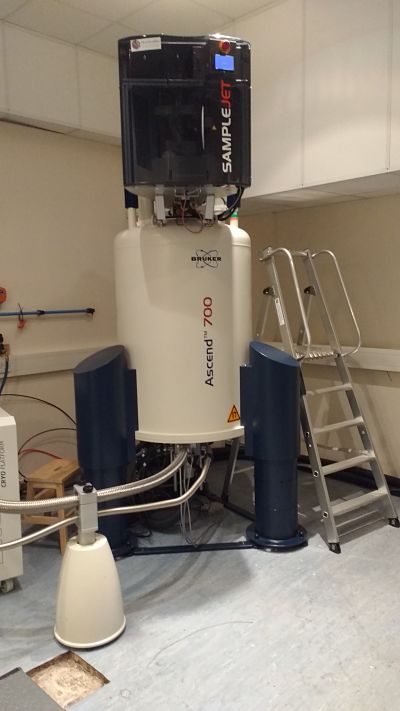Nuclear Magnetic Resonance (NMR)
BrisSynBio is supported via the excellent NMR facilities that are situated in the School of Chemistry. These include a range of NMR machines, including a state of the art 700 MHz spectrometer equipped with a 1.7mm cryoprobe for extreme sensitivity. This is located in the NMR facility in Chemistry, alongside the 600 MHz biological NMR spectrometer.
The facility includes liquid handling robots and refrigerated 96-well cartridge loading robots. These facilitate high-throughput NMR using extremely small quantities (micrograms to nanograms) of protein. This will support natural product research, high throughput screening of protein-protein or protein-ligand interactions, and protein structural biology. The high field coupled with the extremely sensitive cryoprobe will allow you to tackle previously untenable problems.
In addition, the NMR suite supports:
- Computer-assisted structural elucidation.
- Highly sensitive, high resolution 1D and 2D data on < 60 nanomoles.
- High throughput, allowing structural elucidation to be achieved in minutes, especially when supplemented with mass spectrometry data and 1,1-ADEQUATE experiments.
- Bacterial and fungal genomics and natural product mining.
The BrisSynBio 700 MHz instrument has a state-of-the-art 1.7mm cryo-enhanced probe and offers some of the highest sensitivities for 1H NMR in the country. We are able to help obtain structural information at atomic resolution to characterise small molecules and biomolecules in solution. The high field coupled with the extremely sensitive cryoprobe and small sample volume requirements is ideal for limited sample amounts e.g natural products isolated low abundance proteins, peptides or small molecules, difficult-to-express proteins.
Academic Equipment Lead: Professor Matt Crump
Equipment manager: Christopher Williams

Equipment booking
BrisSynBio users are welcome to book our equipment.
Please contact Christopher Williams (C.Williams@bristol.ac.uk) for more information about this equipment, or advice on experimental design and data analysis.